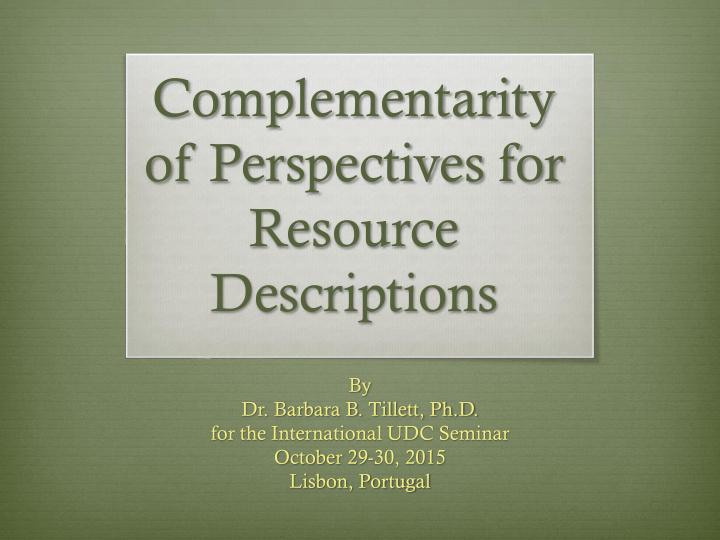



Complementarity of Perspectives for Resource Descriptions By Dr. Barbara B. Tillett, Ph.D. for the International UDC Seminar October 29-30, 2015 Lisbon, Portugal
Resources 2
“ Inherent Work relationships” is realized through Expression is embodied in Manifestation recursive is exemplified by one Item many 3
Work FRBR Work Expression has as subject Subjects Manifestation Item Person Family has as subject Corporate Body Concept Object has as subject Event Place many 4
Description “ Ceci n’est pas une pipe ” René Magritte Bibliographic description
Self-describing Elements Titles “Authors” (i.e., persons, families, corporate bodies associated with the resource) Publication information (places of publication, publishers, dates) Series Identifiers: ISBN, URLs, etc. Etc. (extent, dimensions, etc.) Objective data (helps with “recall” – adjusted through relevance ranking and other algorithms of search engines) 6
Added Descriptors (Added Value) Controlled vocabularies Authority data: name/subject terms Classification numbers Other categorizations (e.g., genre/form) “Added value” images, sound, etc. Subjective data (helps with precision of a search) 7
Multiple Perspectives Bibliographic data Authority data Names (Persons, corporate bodies, families, works/expressions) Classification numbers, Subject terms, Genre/Form 8
Name Authorities VIAF (Virtual International Authority File) Persons Corporate bodies Families Places (geographic names) W orks/expressions (“uniform titles”) Linked to dictionaries, biographical tools, images, and resources and other “Linked data” on the Web 9
VIAF - viaf.org 10
VIAF Languages English French Arabic Italian Portuguese
Subject Authorities Controlled vocabularies Basis/scope Same/similar: LCSH, RAMEAU, RVM Different: LCSH vs. MeSH Coverage Concepts – Biophysics, Literature, History, Thermoreceptors Events – War of 1812 ; Hague, Treaty of, 1717 Historical periods – Jurassic, Post-modern Etc. Some embed links to classification numbers 13
Classification Numbers UDC LCC DDC etc. 14
Different Scripts for Numbers α β γ δ …
Subjects: Lessons Learned IFLA’s MulDiCat – Multilingual Dictionary for Cataloguing Terms and Concepts LCSH/RAMEAU/RVM – linked data experiments MACS (Multilingual Access to Subjects) – LCSH/RAMEAU/GND 16
Mapping: Multilingual Issues 1 1 mathematics matematica algebra algebra Fe iron ž elezo rauta 1 n (one to many) Ambiguity: Football = Soccer? American football? k atumus = remorse,regret,repentance vacation homes = loma-asunnot, lomakodit hiking = vaellus, retkeily 1 0 geyser, tsunami stork
Mapping vs. Complementing Linked data mapping experiments: LCSH/RAMEAU/RVM MACS ALTERNATIVE: Complementarity of terms in bibliographic records
Complementarity Linked bibliographic records for the same resource multiple controlled vocabularies/terms multiple classification numbers linked descriptions with natural language notes Linked digital resource natural language from the resource itself
Roshomon 20
Different Perspectives Different points of view of catalogers/indexers academic background of the person doing the describing training in applying cataloging rules, classification schemes, subject terminology Complement each other Beneficial to add terms/numbers in bibliographic records for the same resource to provide access to the resource 21
Classification Shelf organization = one number But often a work is “about” many topics Classified catalogs – multiple class numbers for retrieval To cover multiple concepts of the work Local budgetary decisions: Limited amount of numbers/terms assigned International links increase subject access 22
Benefits Reduce costs worldwide – share the descriptions, share the work Increase access for researchers/users Let all the descriptors serve – multiple perspectives Share globally 23
Communicating Information 24
Now: Linked Open Data LCSH VIAF 25
Databases, Repositories Services LCC VIAF LCSH Web front end Internet “ Cloud ” 26
Bibliographic Descriptions 27
Future Share globally what each library does locally Current projects, initiatives, etc.? Where will you take us? 28
Suggested Readings Daston, Lorraine and Peter Galison. Objectivity. New York: Zone Books, 2010. (ISBN: 978-1890951795) Ascher, Marcia. Ethnomathematics: a multicultural view of mathematical ideas. Boca Raton: Chapman & Hall, 1994. (ISBN: 0-412-98941-7) Fugmann, Robert (1982). The Complementarity of natural and indexing languages. International Classification, 9 (3), pp. 140-144. “ Library of Congress Controlled Vocabularies and Their Application to the Semantic Web, ” by Corey A. Harper and Barbara B. Tillett. Cataloging & Classification Quarterly, v. 43, no. ¾ (2006), p. 47-68. Also available at: https://scholarsbank.uoregon.edu/dspace/bitstream/1794 /3269/1/ccq_sem_web.pdf [Best paper of CCQ, 2007 award] 29
Suggested Readings, continued Functional Requirements for Authority Data: A Conceptual Model. Edited by Glenn E. Patton. IFLA Working Group on Functional Requirements and Numbering of Authority Records (FRANAR), Final Report, December 2008. Approved by the Standing Committees of the IFLA Cataloguing Section and IFLA Classification and Indexing Section, March 2009. München: K.G. Saur, 2009. (IFLA Series on Bibliographic Control, v. 34) (ISBN: 978-3-598-24382-3) Functional requirements for bibliographic records: final report (1998). IFLA Study Group on the Functional Requirements for Bibliographic records (FRBR), approved by the Standing Committee of the IFLA Section on Cataloguing. München: K. G. Saur. (ISBN: 3-598-11382-X) Functional Requirements for Subject Authority Data (FRSAD): A Conceptual Model (2011). Edited by Marcia Lei Zeng, Maja Ž umer and Athena Salaba. IFLA Working Group on the Functional Requirements for Subject Authority Records (FRSAR). München: De Gruyter Saur. (ISBN: 978-3-11-025323-8) Theory of Subject Analysis: a Sourcebook (1985). Edited by Lois Mai Chan, Phyllis A. Richmond, Elaine Svenonius. Littleton, Colo.: Libraries Unlimited, Inc. (ISBN: 0-87287-489-3)
Recommend
More recommend